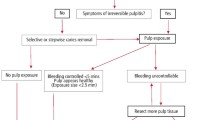Abstract
The maintenance of healthy pulp tissue and the prevention of apical periodontitis form the basis of minimally invasive dentistry. Although, the dental pulp exhibits an array of strategies to protect itself against irritation, the conservative management of the exposed pulp has traditionally been unpredictable. Recent dental biomaterial advances, as well as an evolving understanding of molecular biology and regenerative medicine have led to the development of new treatment strategies for the exposed pulp. Although calcium-silicate cements now represent the gold standard capping material, but stimulate repair non-specifically and have some practical limitations.

Similar content being viewed by others
Further reading
Duncan HF, Yamauchi Y (2019) Current and future views on pulp exposure management and epigenetic influences In: Duncan HF, Cooper PR (eds) Clinical approaches in endodontic regeneration. Springer, Berlin, pp 55–75. https://doi.org/10.1007/978-3-319-96848-3_4
Farges JC, Alliot-Licht B, Renard E et al (2015) Dental pulp defence and repair mechanisms in dental caries. Mediat Inflamm 2015:230251
Nair PN, Duncan HF, Pitt Ford TR, Luder HU (2008) Histological, ultrastructural and quantitative investigations on the response of healthy human pulps to experimental capping with mineral trioxide aggregate: a randomized controlled trial. Int Endod J 41(2):128–150
Ricucci D, Loghin S, Siqueira J Jr (2014) Correlation between clinical and histologic pulp diagnoses. J Endod 40:1932–1939
Sangwan P, Sangwan A, Duhan J, Rohilla A (2013) Tertiary dentinogenesis with calcium hydroxide: a review of proposed mechanisms. Int Endod J 46:3–19
Schwendicke F, Frencken JE, Bjørndal L et al (2016) Managing carious lesions: consensus recommendations on carious tissue removal. Adv Dent Res 28:58–67
Wolters WJ, Duncan HF, Tomson PL, Karim IE, McKenna G, Dorri M, Stangvaltaite L, van der Sluis LWM (2017) Minimally invasive endodontics: a new diagnostic system for assessing pulpitis and subsequent treatment needs. Int Endod J 50:825–829
Duncan HF, Galler KM, Tomson PL, Simon S, El-Karim I, Kundzina R, Krastl G, Dammaschke T, Fransson H, Markvart M, Zehnder M, Bjørndal L, Dummer PMH (2019) European Society of Endodontology position statement: Management of deep caries and the exposed pulp. Int Endod J. https://doi.org/10.1111/iej.13080. (Epub ahead of print)
Author information
Authors and Affiliations
Corresponding author
Additional information
Publisher's Note
Springer Nature remains neutral with regard to jurisdictional claims in published maps and institutional affiliations.
Rights and permissions
About this article
Cite this article
Duncan, H.F., Yamauchi, Y. Pulp exposure management. Clin Dent Rev 3, 4 (2019). https://doi.org/10.1007/s41894-019-0043-y
Received:
Accepted:
Published:
DOI: https://doi.org/10.1007/s41894-019-0043-y




